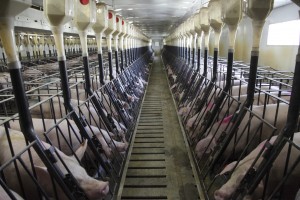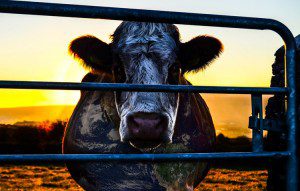Contributing Writer for Wake Up World
Chances are, if you’re concerned about the health of the planet, you’ve most likely come across the following facts and figures: On average, vegans save 1100 gallons of water, 45 pounds of grain, 30 square feet of forest and 20 pounds of CO2 equivalent every day. But what you may not realize is that animal “factory” agriculture is responsible for 18% of greenhouse gas emissions, more than the combined total of all worldwide transportation — including cars, trucks, planes, trains and ships. So we can drive our hybrid cars and bicycle to our heart’s content, recycle religiously and conserve electricity like crazy, but if we consume meat, dairy or eggs, we’re still making a major contribution to the world’s environmental crisis.
In relation to the environment, the problem with eating animal products derived from factory farming methods can be broken down into 5 categories: methane created by livestock, deforestation, feed crops, water use, and unsustainable demand for animal products. The documentary Cowspiracy explores each one, with oftentimes surprising results.
The Environmental Impacts of Animal Agriculture
Coming up against incredible industry opposition, the co-producers of Cowspiracy Kip Andersen and Keegan Kuhn financed the documentary through an Indiegogo campaign, since normal sources of funding weren’t forthcoming. The duo also quickly realized that big names in the environmental movement — Greenpeace, Sierra Club, Rainforest Action Network and others — tend to avoid the issue of livestock as a major cause of global warming. Even Al Gore, the poster child of the environmental movement, is well known to have minimized the significant role factory farming plays in climate change, claiming it would “confuse” people to address methane pollution along with CO2 emissions.
Here’s the rub, though: “Methane has a global warming power 86 times that of CO2,” according to IPPC Working Group I. And it gets worse. The Food and Agriculture Organization of the United Nations highlights the fact that “livestock is responsible for 65% of all emissions of nitrous oxide – a greenhouse gas 296 times more destructive than carbon dioxide and which stays in the atmosphere for 150 years.”
Moreover, mass-scale animal agriculture uses a staggering 55% of available fresh water supplies in the U.S., whereas residential water usage accounts for around 5%. To produce a single gallon of milk, you’re looking at 1,000 gallons of water, while one pound of beef requires an astonishing 2,500 gallons. While many believe pastured animals are a better option for the environment, the documentary challenges that idea as well.
 To give you a bit of perspective, water-intensive fracking uses 100 billion gallons per year in the United States. Contrast this with the 34 trillion gallons of water used each year rearing commercial livestock in the U.S.
To give you a bit of perspective, water-intensive fracking uses 100 billion gallons per year in the United States. Contrast this with the 34 trillion gallons of water used each year rearing commercial livestock in the U.S.
With a rapidly growing worldwide population — paired with looming water shortages and massive rainforest destruction (due to feed crops and cattle) — high-volume animal agriculture is simply and profoundly unsustainable. And yet, while 75% of Americans claim to be environmentalists, only 5% are vegetarian or vegan.
An analysis from Cornell University provides further clarity on the comparative energy efficiency of animal and non-animal agricultures:
On average, animal protein production in the U.S. requires 28 kilocalories (kcal) for every kcal of protein produced for human consumption… Grain production, on average, requires 3.3 kcal of fossil fuel for every kcal of protein produced.
Says Richard A. Oppenlander, author of “Comfortably Unaware: What We Choose to Eat is Killing US and Our Planet”:
“On any given acre of land we can grow twelve to twenty times the amount in pounds of edible vegetables, fruit, and grain as in pounds of edible animal products. We are essentially using twenty times the amount of land and crops and hundreds of times the water, as well as polluting our waterways and air and destroying rainforests, to produce animals to kill and eat.”
It’s good food for thought. After watching Cowspiracy, I’m rethinking my stance on animal products. If we want to take action that has immediate impact on the environment, it seem that reducing or eliminating our reliance on animal products is a significant step we can take.
Please don’t take my word for it. Watch the documentary, share it with your community, do your research and then decide for yourself.
Cowspiracy — Official Trailer
Cowspiracy Official Trailer from First Spark Media.
Article sources:
- “Cowspiracy: The Sustainability Secret” — Kip Anderson, Keegan Kuhn, James McWilliams. A.U.M. Films & First Spark Media.
- The Sustainability Secret: Rethinking Our Diet to Transform the World — Kip Anderson, Keegan Kuhn
- www.cowspiracy.com/facts
- www.ipcc-wg1.unibe.ch
- www.truthdig.com/report/item/saving_the_planet_one_meal_at_a_time_20141109
- www.ecowatch.com/2014/10/10/cowspiracy-exposes-animal-agriculture
- www.news.cornell.edu/stories/1997/08/us-could-feed-800-million-people-grain-livestock-eat
Recommended articles by Carolanne Wright:
- The DARK Act: Monsanto’s Dream Come True, A Waking Nightmare for Clean Food and the Environment
- Big Pharma and Organized Crime — They are More Similar Than You May Think
- Is Roundup Driving The Autism Epidemic? Leading MIT Researcher Says YES
- Over 100 Scientific Studies Agree: Cannabis Annihilates Cancer
- Emotional Energetic Healing: The Future of Medicine is Here
- Why Every Parent Should Consider Unschooling
- The Greenhouse of the Future: Grow Your Own Food Year-Round With This Revolutionary System
- First U.S. City Produces More Electricity Than It Uses — With 100% Renewable Technology
- Autistic Boy with Higher IQ Than Einstein Discovers Gift After Removal from State-Run Therapy
- Enhance Spiritual, Mental and Physical Well-being with a Pineal Gland Detox
- How Being Too Clean Can Lead to Cancer, Multiple Sclerosis, Celiac Disease and More
About the author:
I’m Carolanne — a writer, chef, traveler and enthusiastic advocate for sustainability, organics and joyful living. It’s good to have you here. If you would like to learn more, connect with me at Thrive-Living.net or visit Twitter.com/Thrive_Living.
If you've found value in our articles, we invite you to support the release of our brand-new book, "Gratitude Practices for Kids: A Practical Guide for Adults to Instill a Spirit of Appreciation and Positivity in the Next Generation."
"Gratitude Practices for Kids" brings together over 25 innovative and accessible practices designed to enhance gratitude in everyday life. This comprehensive guide is backed by 17 scientific studies, ensuring each concept is grounded in research, underscoring our commitment to nurturing growth, emotional intelligence, and positive interactions between adults and children.
We encourage you to opt for the paperback version to celebrate this new release. Dive into its fresh pages away from digital distractions, allowing you to immerse yourself in the transformative practices it offers.
Over recent years, Wake Up World has faced significant online censorship, which has impacted our financial ability to operate. Moving into book publishing represents a strategic step to secure the ongoing funds needed to continue our mission. By purchasing Gratitude for Kids, you help us keep our content free and accessible to everyone, avoiding needing a paywall. With over 8,500 articles published in the last 13 years, we remain dedicated to keeping our valuable content open to all.









